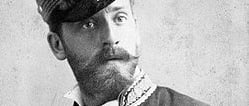Eduard Toda
Eduard Toda i Güell wasn’t the kind of 19th-century gentleman who stayed politely behind a desk. Born in Reus in 1855 and educated in law, Toda launched himself into the Spanish diplomatic service and immediately treated it like a backstage pass to the great theatre of the world. From China’s bustling ports to Egypt’s buried tombs, he moved with the soul of a romantic and the eye of a scholar.
6/8/20255 min read


Eduard Toda i Güell wasn’t the kind of 19th-century gentleman who stayed politely behind a desk arranging treaties and sipping sherry.
Born in Reus in 1855 and educated in law in Madrid, Toda launched himself into the Spanish diplomatic service and immediately treated it like a backstage pass to the great theatre of the world. From China’s bustling ports to Egypt’s buried tombs, he moved with the soul of a romantic, the eye of a scholar, and the humor of someone who once tried to sneak a mummy through customs by declaring it "dried cod."
Toda’s early diplomatic career saw him posted across Asia—Macao, Hong Kong, Canton, and Shanghai—where he developed an incurable fascination for cultures, coins, and cuisines that most Europeans found perplexing or outright alarming. He wasn’t just a curious collector; he was a voracious accumulator. In La vida en el Celeste Imperio (1887), he details his obsession with numismatics, recounting how he spent days haggling over rare Chinese coins, much to the confusion of local merchants who couldn’t quite understand why a Spanish gentleman would care so much about worn copper discs (Toda, Celeste Imperio, p. 48–53).
As for local delicacies, Toda gamely submitted to the rigors of diplomatic banquets. At one, he endured what he referred to as “the most terrifying meal of my life,” consisting of 340 dishes that included fried sparrow heads, duck webs, and sea cucumbers boiled in fermented garlic. He would later write in a letter: “The taste was not entirely disagreeable… if one could get past the idea that the duck’s web was still trying to swim” (unpublished correspondence cited in Vilaplana, 2006, p. 73).
Mummies, Maspero, and the “Dried Cod” Trick
In 1884, Toda was appointed Consul General in Cairo. If Asia had awakened his sense of collection, Egypt lit a full bonfire under his imagination. He struck up a friendship with Gaston Maspero, the eminent French Egyptologist, and was soon donning dusty boots and wielding chisels beside archaeologists in the Valley of the Kings. One of his most vivid memories—chronicled in his magnum opus A través del Egipto (1889)—was the 1886 discovery of the tomb of Sennedjem at Deir el-Medina. “We stood before the sealed wooden door. The stillness of centuries was about to be broken. The Bedouins cheered, and I briefly forgot I was a diplomat and not a grave-robber,” he wrote (Toda, A través del Egipto, p. CXXV).
Yet his most audacious act came not in the field, but at the customs office. After acquiring the mummy of a young boy named Nesi—through entirely legal and documented means, he would insist—Toda faced the problem of getting the child-sized cadaver out of the country. Ever the creative bureaucrat, he labeled it as bacalao seco (dried codfish). The trick worked. Nesi is now safely housed in the Víctor Balaguer Museum, his shipping label a recurring joke among Catalan museum staff (Museu Víctor Balaguer, inventory notes, 1891).
Camel Drama and Museum Hijinks
Toda's time in Cairo wasn’t all tomb dust and papyrus scrolls. His writings betray a man both enchanted and amused by the daily absurdities of colonial Egypt. He once wrapped himself in linen bandages to pose as a mummy in a joke photograph at the Bulaq Museum—likely one of the first examples of 19th-century cosplay, if not archaeological trolling. Unfortunately, the photo has been lost, though several letters describe the event and Maspero’s hysterical reaction (Maspero to Mariette, letter dated March 1887, Bibliothèque nationale de France).
And then there were the camels. Toda despised them. In Son-Notem en Tebas (1887), he grumbles about a “malicious beast who seemed determined to embarrass me by refusing to kneel, and then doing so only once I had already fallen off” (Toda, Son-Notem, p. 22).
Writing with Dust on His Boots and Ink in His Veins
Despite the jokes, Toda's contributions to Egyptology were serious and pioneering. His works Sesostris (1886) and La Muerte en el Antiguo Egipto (1887) were among the first Spanish-language texts to approach ancient Egyptian history with philological rigor. In La Muerte, he reflects, “The dead speak with more dignity than the living; their silence is full of sentences” (Toda, La Muerte, p. 9). This poetic strain runs through all of his work. Underneath the eccentric traveler and diplomatic trickster was a man clearly moved by the vastness of human time and the artifacts left behind. Even in his sardonic footnotes and sarcastic jabs at museum bureaucracy, you sense awe.
The Final and Strangest Collection
After his adventures abroad, Toda’s career took a quieter turn, at least on paper. He served in Helsinki, Le Havre, and London, but the diplomatic dispatches gave way to essays, lectures, and the slow, meticulous business of building a legacy. In 1918, he bought and moved into the semi-ruined Monestir d’Escornalbou in Tarragona. The average retiree might pick up gardening or chess. Toda converted a monastery into his personal museum-library-laboratory. There, surrounded by dusty tomes, Buddhist statuary, and the occasional sarcophagus, he hosted intellectuals, historians, and the bemused rural neighbors who came up the hill to see if the rumors about the “crazy mummy man” were true.
He catalogued his collections with academic discipline but never lost his affection for the absurd. In one margin of a manuscript he noted, next to the description of a Theban canopic jar, “It looks like it could double as a wine cooler—but that would be unwise given the owner's presumed curse” (Manuscrits de l’Arxiu Escornalbou, box 12, note 41).
Footnotes, Failures, and Funeral Masks
Throughout his writings, Toda is preoccupied with time—how people recorded it, resisted it, or were crushed by it. But he never wallows. Instead, he laughs with the ancients. In A través del Egipto, after pages of reverent description of the tomb of Ramses III, he notes how one inscription had been clumsily repaired by a 19th-century restorer who used, quite literally, “plaster and very little shame” (Toda, A través del Egipto, p. 203). His tone shifts constantly: from scholarly to playful, from romantic to biting. He was perhaps at his most candid in private notebooks, where he mocked his own shortcomings. On one failed translation of a hieroglyphic epithet, he wrote: “Either he was a priest of Ptah or a very enthusiastic baker. The symbols are ambiguous and my breakfast was late” (Quaderns d’Egipte, private notes, Escornalbou Archive).
Eduard Toda’s real journey, if you can call it that, was an internal one. His travels were not merely diplomatic postings but pilgrimages in search of context, connection, and sometimes comic relief. Few Spaniards of the 19th century could claim to have dined with Chinese mandarins, ridden donkeys to Thebes, and held the funerary mask of an Egyptian artisan—all before lunch. His scholarly works (Sesostris, La Muerte en el Antiguo Egipto, A través del Egipto, Son-Notem en Tebas) remain foundational in Spanish Egyptology. But it’s the man himself—canny, funny, slightly mad, deeply human—who continues to fascinate. Whether you remember him for his camel complaints, mummy-smuggling escapades, or his ability to find time to write through earthquakes and revolutions, Eduard Toda was never boring. And if the boy from Reus had been forced to summarize his life’s goal, he might have said, with a dry Catalan shrug: “To understand the world, and if possible, to confuse it slightly in the process.”
